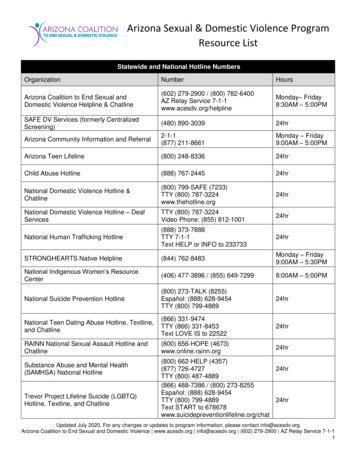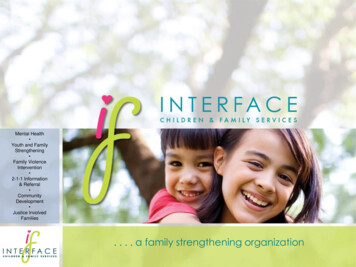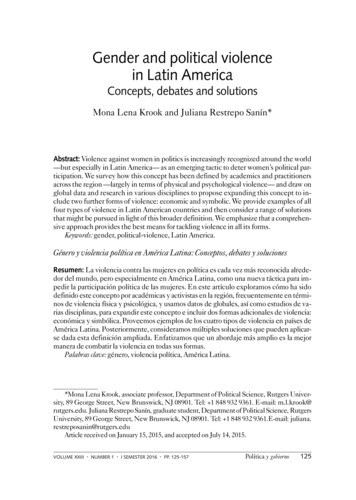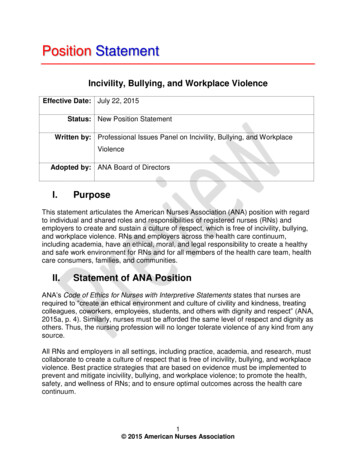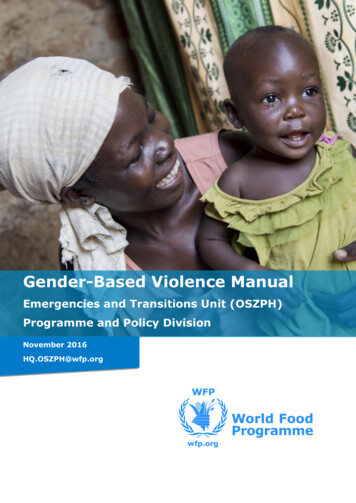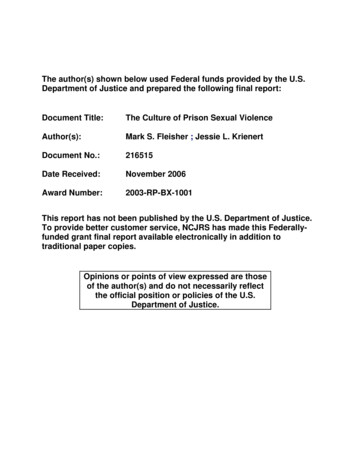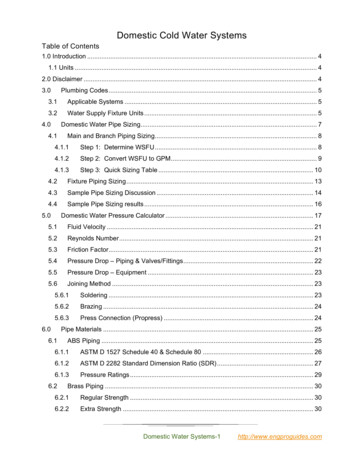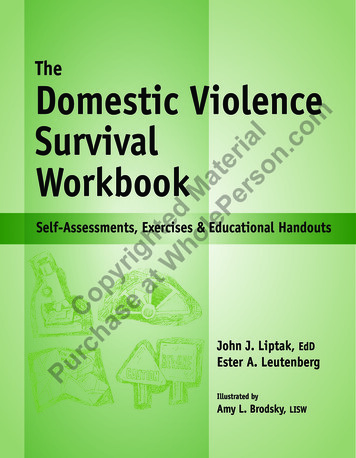
Transcription
TheTheCch oas pye rigat hW tedho Mle atPe errs urvivalWorkbookWorkbookSelf-Assessments, Exercises & Educational HandoutsSelf-Assessments, Exercises& Educational HandoutsJohn J. Liptak, EdDEster A. LeutenbergIllustrated byPurAmy L. Brodsky, LISWJohn J. Liptak, EdDEster A. LeutenbergIllustrated byAmy L. Brodsky, LISW
Cch oas pye rigat hW tedho Mle atPe errs ialon.com101 W. 2nd St., Suite 203Duluth, MN son.comThe Domestic Violence Survival WorkbookSelf-Assessments, Exercises & Educational HandoutsCopyright 2009 by John J. Liptak and Ester A. Leutenberg.All rights reserved. Except for short excerpts for review purposesand materials in the assessment, journaling activities, andeducational handouts sections, no part of this book may bereproduced or transmitted in any form by any means, electronicor mechanical, including photocopying without permission inwriting from the publisher.Printed in the United States of America10 9 8 7 6 5 4 3 2PurEditorial Director: Carlene SippolaArt Director: Joy Morgan DeyLibrary of Congress Control Number: 2008942358ISBN: 978-1-57025-231-0
Using This Book(For the professional)Cch oas pye rigat hW tedho Mle atPe errs ialon.comOver the past few decades the problems of family violence and domestic abuse have beenbrought to the forefront of our consciousness. The reality is that domestic violence occurs infamilies of all races, cultures, and socio-economic levels. Recognizing early warning signs iscritical in the reduction of domestic violence. Part of the problem is that domestic violenceencompasses many different types of abuse: Physical abuse includes slapping, hitting, punching, shoving, kicking, choking,pushing, grabbing, pulling hair, depriving of food, light and/or water, and many otherways of physically harming another person. Sometimes physical abuse involves beinghit with a weapon or an object, or even left alone in dangerous places or tied up andleft for periods of time. Sexual abuse is when a partner is forced to participate in sexual situations againsthis or her will. This can include sexual intercourse when the partner is not fullyconscious, has not given consent, or is afraid to say no. This might also includesexual situations in which one partner coerces the other to engage in sexual activitiesthat are not mutually agreed upon. Psychological, emotional or verbal abuse is when one partner threatens,humiliates, excessively blames, puts-down, intimidates or otherwise psychologicallyhurts the other partner. This may include situations in which a partner is made tofeel inferior, stupid or lazy. This type of abuse can also take the form of one partnerdepriving the other of things they need or keeping them away from other people. Financial abuse occurs when a partner takes financial advantage by cashing checkswithout permission, taking money and personal belongings, forging a partner’ssignature, lying about how much money they have, or using deception, scare tactics,trickery or false pretence for financial gain. Multiple forms of abuse are when one partner abuses the other partner in morethan one of the ways listed.Professionals agree that domestic violence is very complex and can take many differentforms. Abusers can include spouses, boyfriends and girlfriends, same-sex partners,roommates and friends. It may appear that the obvious and simple solution to this problem isthat a domestic violence survivor should just leave the abuser and the abusive relationship.Many reasons exist to indicate why this is not always possible or desirable on the part ofthe abused. The good news is that skills for recognizing and effectively dealing with abusiverelationships can be learned.PurOver the last century many different workbooks, workshops and self-help systems havebeen designed to help people explore ways of overcoming abusive relationships. In thepast twenty years, many research studies have focused on the value of self-reflection andjournaling as a way of exploring personal characteristics, identifying ineffective behaviors,and examining thoughts and feelings that lead to these ineffective behaviors. This book isunique in that it combines two powerful psychological tools designed to enhance domesticviolence coping skills: self-assessment and journaling.
Using This Book(For the professional, continued)Cch oas pye rigat hW tedho Mle atPe errs ialon.comDifferent cultures construct relationships and gender in different ways, For example, somecultures expect relationships to include more possessiveness and even a healthy relationshipmay score high on the Scales. This does not always indicate a higher incidence of abusein this community. While the book attempts to be inter-culturally relevant and sensitive,therapists and other professionals must use discretion, sensitivity and cultural competency intheir use of these materials.The Domestic Violence Survival Workbook contains five separate sections that will helpparticipants learn more about themselves as well as the impact of domestic violence in theirlives and the lives of their family members. The five sections of this book are: SYMPTOMS OF ABUSE SCALE helps survivors to explore the extent to which abuseis having on their physical wellness, emotions, thought patterns and detachment fromothers. TYPES of ABUSE SCALE helps survivors explore and examine their relationship withparents, siblings, grandparents, children, friends and work colleagues. It includes acomprehensive 10-page safety plan. Please stress the comments in the bottom box ofeach page on how to keep the Safety Plan SAFE! PARTNER BEHAVIOR SCALE helps individuals identify if they are in a potentiallyabusive relationship. ELDER ABUSE SCALE helps survivors of elder abuse explore, examine and manage avariety of emotions. SELF-EMPOWERMENT SCALE helps survivors examine if they are successfullymoving on from the trauma of abuse and living the life they have dreamed of living.These sections serve as avenues for individual self-reflection, as well as for groupexperiences revolving around identified topics of importance. Each assessment includesdirections for easy administration, scoring and interpretation. Each section includesexploratory activities, reflective journaling activities and educational handouts to helpparticipants discover their habitual, ineffective methods of managing domestic violence andexploring new ways to bring about healing.PurThe art of self-reflection goes back many centuries and is rooted in many of the world’sgreatest spiritual and philosophical traditions. Socrates, the ancient Greek philosopher,was known to walk the streets engaging the people he met in philosophical reflection anddialogue. He felt that this type of activity was so important in life that he went so far as toproclaim, “The unexamined life is not worth living!” The unexamined life is one in which thesame routine is continually repeated without ever thinking about its meaning to one’s lifeand how this life really could be lived. However, a structured reflection and examination ofbeliefs, assumptions, characteristics, and patterns can provide a better understanding, whichcan lead to a more satisfying life. A greater level of self-understanding about important lifeskills is often necessary to make positive, self-directed changes in the negative patterns thatkeep repeating throughout life. The assessments and exercises in this book can help promotethis self-understanding. Through involvement in the in-depth activities, the participant claimsownership in the development of positive patterns.
Cch oas pye rigat hW tedho Mle atPe errs ialon.comJournaling is an extremely powerful tool for enhancing self-discovery, learning, transcendingtraditional problems, breaking ineffective life habits, and helping to heal from psychologicaltraumas of the past. From a physical point of view, writing reduces stress and lowers muscletension, blood pressure and heart rate levels. Psychologically, writing reduces sadness,depression and general anxiety, and leads to a greater level of life satisfaction and optimism.Behaviorally, writing leads to enhanced social skills, emotional intelligence and creativity. Italso leads to improved writing skills which leads to more self-confidence in the workplace.By combining reflective assessment and journaling, your participants will be exposed toa powerful method of combining verbalizing and writing to reflect and solve problems,becoming more aware of domestic violence in their lives.Preparation for using the assessments and activities in this book is important.The authors suggest that prior to administering any of the assessments in thisbook, you complete them yourself. This will familiarize you with the format of theassessments, the scoring directions, the interpretation guides and the journalingactivities. Although the assessments are designed to be self-administered, scoredand interpreted, it helps for facilitators to be prepared to answer questions aboutthe assessments for participants.PurWith your background and experience, as well as familiarity with the scales, youshould be able to clarify for participants any confusing words or phrases.
The Assessments, Journaling Activitiesand Educational HandoutsCch oas pye rigat hW tedho Mle atPe errs ialon.comThe Assessments, Journaling Activities, and Educational Handouts in The Domestic ViolenceSurvival Workbook are reproducible and ready to be photocopied for participants’ use.Assessments contained in this book focus on self-reported data and are similar to ones usedby psychologists, counselors, therapists and career consultants. Accuracy and usefulnessof the information provided is dependent on the truthful information that each participantprovides through self-examination. By being honest, participants help themselves to learnabout unproductive and ineffective patterns, and to uncover information that might bekeeping them from being as happy and/or as successful as they might be.An assessment instrument can provide participants with valuable information aboutthemselves; however, it cannot measure or identify everything about them. The purposes ofthe assessments are not to pigeon-hole certain characteristics, but rather to allow participantsto explore all of their characteristics. This book contains self-assessments, not tests. Testsmeasure knowledge or whether something is right or wrong. For the assessments in thisbook, there are no right or wrong answers. These assessments ask for personal opinions orattitudes about a topic of importance in the participant’s career and life.When administering assessments in this workbook, remember that the items are genericallywritten so that they will be applicable to a wide variety of people but will not account forevery possible variable for every person. The assessments are not specifically tailored to oneperson. Use them to help participants identify negative themes in their lives and find ways tobreak the hold that these patterns and their effects have.Advise the participants taking the assessments that they should not spend too much timetrying to analyze the content of the questions; their initial response will most likely be true.Regardless of individual scores, encourage participants to talk about their findings and theirfeelings pertaining to what they have discovered about themselves. Talking about abusivepatterns and relationships can enhance the life of participants. These domestic violenceexercises can be used by group facilitators working with either potential victims of domesticviolence or past or present survivors of domestic violence.PurA particular score on any assessment does not guarantee a participant’s level of safety ordanger in a relationship. Use discretion when using any of the information or feedbackprovided in this workbook. The use of these assessments should not be substituted forconsultation and/or safety planning with a domestic violence professional. Should theparticipants experience any emotional, mental, or physical problems, they need to consult aqualified mental health care professional.Thanks to the following professionals whose input in this bookhas been so valuable!Carol Butler, MS Ed, RN, C, Nancy Day, OT Reg (Ont), Eileen Regen, M.Ed., CJESpecial thanks to Kerry Moles, CSW and Shayna Livia Korb, BSfor their expertise on the crucial topic of Domestic Violence.Without their thought-provoking questions and professional insights,this book would not have been possible.
Layout of the BookCch oas pye rigat hW tedho Mle atPe errs ialon.comThe Domestic Violence Survival Workbook is designed to be used either independently oras part of an integrated curriculum. You may administer one of the assessments and thejournaling exercises to an individual or a group with whom you are working, or you mayadminister a number of the assessments over one or more days.This book includes five sections, each of which contains: Assessment Instruments – Self-assessment inventories with scoring directions andinterpretation materials. Group facilitators can choose one or more of the activitiesrelevant to their participants. Activity Handouts – Practical questions and activities that prompt self-reflection andpromote self-understanding. These questions and activities foster introspection andpromote pro-social behaviors. Reflective Questions for Journaling – Self-exploration activities and journalingexercises specific to each assessment to enhance self-discovery, learning and healing. Educational Handouts – Handouts designed to enhance instruction can be usedindividually or in groups to enhance awareness of abuse and abusive relationships.They can be distributed, converted into masters for overheads or transparencies, orwritten down on a board and discussed.Who should use this program?This book has been designed as a practical tool for helping professionals, such as therapists,counselors, psychologists, teachers, group leaders, etc. Depending on the role of theprofessional using The Domestic Violence Survival Workbook and the specific group’s needs,these sections can be used individually, combined, or as part of an integrated curriculum fora more comprehensive approach.Why use self-assessments?Self-assessments are important in teaching various domestic violence survival skills.Participants will: Become aware of the primary motivators that guide their behavior. Explore and learn to indentify situations that are potentially harmful. Explore the effects of unconscious childhood messages. Gain insight that will guide behavioral change.Pur Focus their thinking on behavioral goals for change. Uncover resources they possess that can help them to cope with problems anddifficulties. Explore their personal characteristics without judgment. Develop full awareness of their strengths and weaknesses.Because the assessments are presented in a straightforward and easy-to-useformat, individuals can self-administer, score, and interpret each assessment attheir own pace.
Introduction for the ParticipantCch oas pye rigat hW tedho Mle atPe errs ialon.comDomestic violence is the number one cause of injury to women and men in the United States.Domestic violence is a crime that cuts across all racial, cultural, age and socio-economic lines.Violence at home between partners can take many forms including physical, sexual, financial,verbal and emotional abuse. Most men and women who abuse their partners tended towitness violence in their own family as they were growing up or were abused as children.People who have been abused often believe they somehow cause the abuse, or that they cancontrol the abuse by pleasing his or her partner or not causing him or her to get angry. If youare one of those people, you probably are still exhibiting a variety of symptoms that disruptyour life, your relationship with others, your work, and your family interactions. Some of thethoughts, feelings and behaviors of abuse survivors include: Low self-esteem Controlling behaviors Lack of trust Anxiety Guilt about being responsible for the abuse Fear of abandonmentThe good news is that if you are possibly about to be abused by someone, being abusednow, or have been abused in the past, this book can help you! Many abusers are not evenaware of the patterns and triggers for their abusive actions. On the other hand, many peoplebeing abused find themselves caught up in a cycle of abuse that follows a common pattern intheir relationships.This book relies on assessments and journaling activities to help you reflect on yourself andyour relationships. This method is both educational and therapeutic. The Domestic ViolenceSurvival Workbook is designed to help you learn about the types of abuse, how to take bettercare of yourself, and how to identify abusive personality characteristics.Many people who were abused go on to abuse others.PurIf you have concerns about this issue, please call the National Domestic ViolenceHotline at 1-800-799-7233.
The Domestic Violence Survival WorkbookTABLE OF CONTENTSSECTION I – Symptoms of AbuseCch oas pye rigat hW tedho Mle atPe errs ialon.comSymptoms of Abuse ScaleDirections . . . . . . . . . . . . . . . . . . . . . . . . . . . . . . . . . . . . . . . . 15Symptoms of Abuse Scale . . . . . . . . . . . . . . . . . . . . . . . . . . . . 16Scoring Directions . . . . . . . . . . . . . . . . . . . . . . . . . . . . . . . . . . . 18Profile Interpretation . . . . . . . . . . . . . . . . . . . . . . . . . . . . 18 – 22Activity HandoutsStaying in the Present . . . . . . . . . . . . . . . . . . . . . . . . . . . . . . . 23Exercise . . . . . . . . . . . . . . . . . . . . . . . . . . . . . . . . . . . . . . . . . . 23Affirmations . . . . . . . . . . . . . . . . . . . . . . . . . . . . . . . . . . . . . . . 24Listen to Music . . . . . . . . . . . . . . . . . . . . . . . . . . . . . . . . . . . . . 24Visualization . . . . . . . . . . . . . . . . . . . . . . . . . . . . . . . . . . . . . . . 25Thought Stopping . . . . . . . . . . . . . . . . . . . . . . . . . . . . . . . . . . . 25Breathing . . . . . . . . . . . . . . . . . . . . . . . . . . . . . . . . . . . . . . . . . 26Progressive Relaxation . . . . . . . . . . . . . . . . . . . . . . . . . . . . . . . 27Meditation . . . . . . . . . . . . . . . . . . . . . . . . . . . . . . . . . . . . . . . . 27Nutrition . . . . . . . . . . . . . . . . . . . . . . . . . . . . . . . . . . . . . . . . . 28Engage in Simple Pleasures . . . . . . . . . . . . . . . . . . . . . . . . . . . 28Journaling ActivitiesLearn? . . . . . . . . . . . . . . . . . . . . . . . . . . . . . . . . . . . . . . . . . . . 29Work On? . . . . . . . . . . . . . . . . . . . . . . . . . . . . . . . . . . . . . . . . . 30Stress Management Plan? . . . . . . . . . . . . . . . . . . . . . . . . . . . . . 31Educational HandoutsSome Long-Term Effects of Abuse . . . . . . . . . . . . . . . . . . . . . . 32PurFears in Leaving an Abusive Situation . . . . . . . . . . . . . . . . . . . 33SECTION II – Types of AbuseTypes of Abuse ScaleDirections . . . . . . . . . . . . . . . . . . . . . . . . . . . . . . . . . . . . . . . . 37Types of Abuse Scale . . . . . . . . . . . . . . . . . . . . . . . . . . . . 38 – 39Scoring Directions . . . . . . . . . . . . . . . . . . . . . . . . . . . . . . . . . . . 40Profile Interpretation . . . . . . . . . . . . . . . . . . . . . . . . . . . . 41 – 42
TABLE OF CONTENTS (continued)Activity HandoutsCch oas pye rigat hW tedho Mle atPe errs ialon.comSafety Plan #1 – Things to Do to Be Safe . . . . . . . . . . . . . . . . . 43Safety Plan #2 – Supportive Neighbors and Friends . . . . . . . . . 44Safety Plan #3 – Leaving Your Home Safely . . . . . . . . . . . . . . . 45Safety Plan #4 – What Would You Take? . . . . . . . . . . . . . . . . . . . 46Safety Plan #5 – Children . . . . . . . . . . . . . . . . . . . . . . . . . . . . . 47Safety Plan #6 – Supportive People . . . . . . . . . . . . . . . . . . . . . 48Safety Plan #7 – Your Safety . . . . . . . . . . . . . . . . . . . . . . . . . . . 49Safety Plan #8 – Other Ways to Protect Yourself (and Children) 50Safety Plan #9 – My Plan . . . . . . . . . . . . . . . . . . . . . . . . . . . . . 51Safety Plan #10 – Safety of My Children . . . . . . . . . . . . . . . . . . 52Journaling ActivitySevere Abuse . . . . . . . . . . . . . . . . . . . . . . . . . . . . . . . . . . . . . . 53Educational HandoutsCycle of Abuse . . . . . . . . . . . . . . . . . . . . . . . . . . . . . . . . . . . . . 54Some Examples of Abuse . . . . . . . . . . . . . . . . . . . . . . . . . . . . . 55SECTION III – Partner BehaviorPartner Behavior ScaleDirections . . . . . . . . . . . . . . . . . . . . . . . . . . . . . . . . . . . . . . . . 59Partner Behavior Scale . . . . . . . . . . . . . . . . . . . . . . . . . . . 60 – 61Scoring Directions . . . . . . . . . . . . . . . . . . . . . . . . . . . . . . . . . . . 62Profile Interpretation . . . . . . . . . . . . . . . . . . . . . . . . . . . . . . . . 62Profile Interpretation Scale I – Jealousy . . . . . . . . . . . . . . . . . . . 63Profile Interpretation Scale II – Control . . . . . . . . . . . . . . . . . . . 64PurProfile Interpretation Scale III – Lifestyle . . . . . . . . . . . . . . . . . . 65Profile Interpretation Scale IV – Abusive Behavior . . . . . . . . . . . 66Activity HandoutsSelf-Advocacy . . . . . . . . . . . . . . . . . . . . . . . . . . . . . . . . . . . . . 67Negatives . . . . . . . . . . . . . . . . . . . . . . . . . . . . . . . . . . . . . . . . . 68Helplessness . . . . . . . . . . . . . . . . . . . . . . . . . . . . . . . . . . . . . . . 69Developing Positive Connections with Other People . . . . . . . . 70Healthy Relationships Worksheet . . . . . . . . . . . . . . . . . . . . . . . 71
TABLE OF CONTENTS (continued)Unhealthy Relationships Worksheet . . . . . . . . . . . . . . . . . . . . . 72Cch oas pye rigat hW tedho Mle atPe errs ialon.comChanging Unhealthy Relationships . . . . . . . . . . . . . . . . . . . . . 73Journaling ActivitiesTrusting Relationships . . . . . . . . . . . . . . . . . . . . . . . . . . . . . . . 74An Ideal Relationship . . . . . . . . . . . . . . . . . . . . . . . . . . . . . . . . 75Ideal Qualities . . . . . . . . . . . . . . . . . . . . . . . . . . . . . . . . . . . . . 76Educational HandoutsHealthy Relationshiops . . . . . . . . . . . . . . . . . . . . . . . . . . . . . . . 77Indicators of an Unhealthy Relationship . . . . . . . . . . . . . . . . . 78SECTION IV – Elder AbuseElder Abuse ScaleDirections . . . . . . . . . . . . . . . . . . . . . . . . . . . . . . . . . . . . . . . . 81Elder Abuse Scale . . . . . . . . . . . . . . . . . . . . . . . . . . . . . . . 82 – 83Scoring Directions . . . . . . . . . . . . . . . . . . . . . . . . . . . . . . . . . . . 84Profile Interpretation . . . . . . . . . . . . . . . . . . . . . . . . . . . . . . . . 84Scale Descriptions . . . . . . . . . . . . . . . . . . . . . . . . . . . . . . . . . . . 85Activity HandoutsSelf-Esteem Exercises . . . . . . . . . . . . . . . . . . . . . . . . . . . . . . . . 86Daily Feelings Log . . . . . . . . . . . . . . . . . . . . . . . . . . . . . . . . . . . 87Anxiety Exercises . . . . . . . . . . . . . . . . . . . . . . . . . . . . . . . 88 – 89Guilt-Rlated Exercises . . . . . . . . . . . . . . . . . . . . . . . . . . . . . . . 90Forgiving Yourself . . . . . . . . . . . . . . . . . . . . . . . . . . . . . . . . . . . 91Depression Exercises . . . . . . . . . . . . . . . . . . . . . . . . . . . . . . . . 92Converting Negativity into Positive Outcomes . . . . . . . . . . . . . 93Putting It All Together . . . . . . . . . . . . . . . . . . . . . . . . . . . . . . . 94PurHow Has Abuse Affected Me? . . . . . . . . . . . . . . . . . . . . . . . . . 95Journaling ActivitiesWho Supports Me? . . . . . . . . . . . . . . . . . . . . . . . . . . . . . . . . . . 96My Safety Plan . . . . . . . . . . . . . . . . . . . . . . . . . . . . . . . . . . . . . 97Educational HandoutsTypes of Elder Abuse . . . . . . . . . . . . . . . . . . . . . . . . . . . . . . . . 98Barriers . . . . . . . . . . . . . . . . . . . . . . . . . . . . . . . . . . . . . . . . . . . 99
TABLE OF CONTENTS (continued)SECTION V – Self-EmpowermentCch oas pye rigat hW tedho Mle atPe errs ialon.comSelf-Empowerment ScaleDirections . . . . . . . . . . . . . . . . . . . . . . . . . . . . . . . . . . . . . . . 103Self-Empowerment Scale . . . . . . . . . . . . . . . . . . . . . . . 104 – 105Scoring Directions . . . . . . . . . . . . . . . . . . . . . . . . . . . . . . . . . . 106Profile Interpretation . . . . . . . . . . . . . . . . . . . . . . . . . . . . . . . 107Scale Descriptions . . . . . . . . . . . . . . . . . . . . . . . . . . . . . . . . . . 108Activity HandoutsIncreasing Your Self-Esteem . . . . . . . . . . . . . . . . . . . . . . . . . . 109Pride . . . . . . . . . . . . . . . . . . . . . . . . . . . . . . . . . . . . . . . . . . . 110My Positive Self . . . . . . . . . . . . . . . . . . . . . . . . . . . . . . 111 – 112Stop Feeling Guilty . . . . . . . . . . . . . . . . . . . . . . . . . . . . . . . . . 113Your Wants and Needs . . . . . . . . . . . . . . . . . . . . . . . . . . . . . . 114Non-Assertive Situations . . . . . . . . . . . . . . . . . . . . . . . . . . . . 115Emotional Dependence . . . . . . . . . . . . . . . . . . . . . . . . . . . . . . 116Journaling ActivitiesI Do Well . . . . . . . . . . . . . . . . . . . . . . . . . . . . . . . . . . . . . . . . . 117The Guilts . . . . . . . . . . . . . . . . . . . . . . . . . . . . . . . . . . . . . . . 118Assertiveness . . . . . . . . . . . . . . . . . . . . . . . . . . . . . . . . . . . . . 119Educational HandoutsStress . . . . . . . . . . . . . . . . . . . . . . . . . . . . . . . . . . . . . . . . . . . 120PurCommon Guilt Issues . . . . . . . . . . . . . . . . . . . . . . . . . . . . . . . 121
SECTION I:Cch oas pye rigat hW tedho Mle atPe errs ialon.comSymptomsof AbuseScalePurNameDate 2009 WHOLE PERSON ASSOCIATES, 101 W. 2ND ST., SUITE 203, DULUTH MN 55802 800-247-678913
Cch oas pye rigat hW tedho Mle atPe errs ialon.comPur14 2009 WHOLE PERSON ASSOCIATES, 101 W. 2ND ST., SUITE 203, DULUTH MN 55802 800-247-6789
SECTION I: SYMPTOMS OF ABUSE SCALESymptoms of Abuse Scale DirectionsCch oas pye rigat hW tedho Mle atPe errs ialon.comDomestic violence is a pattern of behavior in an intimate relationship that is used to obtainand maintain power and control over an intimate partner. Stress is often the result of thisabuse. The Symptoms of Abuse Scale is designed to help you explore different types ofsymptoms that you may be experiencing that are related to stress.This booklet contains statements that are divided into four categories. Read each of thestatements and decide how descriptive the statement is of you. In each of the choices listed,circle the number of your response on the line to the right of each statement.In the following example, the circled 1 indicates that the statement is not at all descriptive ofthe person completing the inventory:A LotLike MeSomewhatLike MeA LittleLike MeNotLike Me4321I. I find that . . .I feel detached from other people around mePurThis is not a test and there are no right or wrong answers. Do not spend too much timethinking about your answers. Your initial response will be the most true for you. Be sure torespond to every statement.(Turn to the next page and begin) 2009 WHOLE PERSON ASSOCIATES, 101 W. 2ND ST., SUITE 203, DULUTH MN 55802 800-247-678915
SECTION I: SYMPTOMS OF ABUSE SCALESymptoms of Abuse ScaleA Lot Somewhat A LittleNotLike Me Like MeLike Me Like MeI. I find that . . .4321I have lost interest in important social activities4321I have lost interest in my job4321I have lost interest in hobbies and sports4321I avoid activities or places that remind me ofthe abuse4321I avoid people or conversations that remind meof the abuse4321I have difficulty being around my friends4321I try to avoid feelings that remind me of the abuse4321Cch oas pye rigat hW tedho Mle atPe errs ialon.comI feel detached from other people around meDETACHED TOTAL A Lot Somewhat A LittleNotLike Me Like MeLike Me Like MeII. I find that . . .4321I am jumpy if startled by sudden noises4321I have recurring panic attacks4321I often have an upset stomach4321I am experiencing a decrease or increaseof appetite4321I am tired a lot of the time4321I frequently have a dry mouth or throat4321I often feel anxious4321PurI have frequent headachesPHYSICAL SYMPTOMS TOTAL (Continued on the next page)16 2009 WHOLE PERSON ASSOCIATES, 101 W. 2ND ST., SUITE 203, DULUTH MN 55802 800-247-6789
SECTION I: SYMPTOMS OF ABUSE SCALE(Symptoms of Abuse Scale, continued)A Lot Somewhat A LittleNotLike Me Like MeLike Me Like MeIII.I find that . . .4321I get mental pictures of the abuse without beingreminded of it4321I am unable to remember parts of the abuse4321I am unable to remember my life during the abuse4321I have sudden flashbacks of the abuse4321I have difficulty falling asleep4321I relive the abuse in my mind4321I have a hard time concentrating4321Cch oas pye rigat hW tedho Mle atPe errs ialon.comI think about the abuse a lot of the timeCOGNITIVE TOTAL A Lot Somewhat A LittleNotLike Me Like MeLike Me Like MeIV. I find that . . .4321I feel guilty about the abuse4321I have bad dreams and nightmares4321I get emotionally upset when I think aboutthe abuse4321I don’t know who to trust4321I am on guard most of the time4321I am irritable a lot of the time4321I have feelings of hopelessness4321PurI feel numb emotionallyEMOTIONS TOTAL (Go to the Scoring Directions on the next page) 2009 WHOLE PERSON ASSOCIATES, 101 W. 2ND ST., SUITE 203, DULUTH MN 55802 800-247-678917
SECTION I: SYMPTOMS OF ABUSE SCALESymptoms of Abuse Scale Scoring DirectionsCch oas pye rigat hW tedho Mle atPe errs ialon.comThe Symptoms of Abuse Scale is designed to
helps survivors explore and examine their relationship with parents, siblings, grandparents, children, friends and work colleagues. It includes a comprehensive 10-page safety plan. Please stress the comments in the botto
